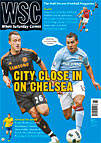 Only minutes from the London 2012 site lies a very different sort of sporting venue. Ian Aitch visits the Old Spotted Dog
Only minutes from the London 2012 site lies a very different sort of sporting venue. Ian Aitch visits the Old Spotted Dog
As any true football fan knows, even the sight of five ten-year-old kids playing three-and-in is enough to make you watch back over your shoulder as you walk across the park. So, as you can imagine, moving so close to a real football ground that an errant shot of Geoff Thomas proportions could end up in your back garden is the kind of thing that makes you divert the walk to the corner shop, just so you can admire the floodlights peeking up from behind the fence.
In my case this ground is the Old Spotted Dog Ground, belonging to Clapton FC. The east London club have been here since they were formed in 1878, though the ground is actually about four miles from Clapton and is located in Forest Gate, just a mile across the park from West Ham’s Boleyn Ground.
This odd combination of name and location may well go some way to explaining the club’s inability to bring in much of a following from either Clapton or Forest Gate. The Essex Senior League club’s record of played five, lost five on the day I make my way to my first Clapton game could indicate why the attendance rarely exceeds the high teens. There seems little danger of them putting in a late bid to take on the Olympic Stadium in Stratford, despite being longer standing local residents than the Hammers.
It was not always this way. The club’s heyday was 100 years ago, with a rash of FA Amateur Cup wins and a strong showing in the Isthmian League. The Tons were founder members of the Southern League and hold the claim to being the first English side to play on the continent, beating a Belgium XI in 1892. Clapton even provided England with three international players in the 1920s, having also honed the skills of Walter Tull before he made his famous move across London to Spurs in 1909.
The entrance to the stadium is situated between the now-derelict Old Spotted Dog pub and a tyre-fitters, with a sign advertising a long-defunct club website alerting passing locals to the team’s existence. There are several of these low-tech Clapton websites, but none with anything like an up-to-date fixture list, making it hard to work out when the team are playing at home. One, claptonfootballclub.com, however, does bear reading, if only for the flamboyant use of a club website for a managerial resignation.
Problems occur at the gate when it materialises that the chairman, who is elsewhere, has left the match programmes in the boot of his car. So, until he turns up at half-time, I have to make do with the players’ names shouted out from an enthusiastic young fan sat behind me in the 70-seat main stand. As the attacking midfielder is the lad’s uncle I get to know the player only as “uncle”. The youngster does not shy away from slating his relative’s positioning, berating him like a jaded fan 40 years his senior. The only other player that he knows well enough to shout at is “Ninja”, a speedy teenage left-back who almost lives up to his nickname by ghosting past Basildon Utd’s right-back in a flank attack worthy of a team much further up the non-League pyramid.
For the first five minutes Clapton are all about getting it to the byline, cutting inside the full-back and making Basildon look like unsophisticated hoofers. Sadly, this does not last. Basildon start to show real organisation, exposing Clapton’s lack of anything resembling a cohesive team spirit as well as their fondness for a rash challenge in dangerous positions. Ninja, who turns out to actually be called Fahad Nyanja, goes missing and eventually limps off. Manager Wilfred Thomas takes to throwing put-downs rather than encouragement.
As a Basildon’s weighty captain heads in a third goal Clapton look very much like a sorry bunch of Hackney Marshes no-hopers, complete with their unbadged, unsponsored shirts, which only approximate the official club colours (red-and-black stripes instead of the traditional red-and-white).
The second-half substitutions don’t help much, with youth only adding a lack of strength to the midfield. A handful of supporters try some coaching from the goal that Clapton are attacking, which seems to help a little. But it is too little too late. A fourth Basildon goal comes and the Clapton attackers can hardly muster enough energy to make their poor efforts go out for a goal kick, never mind balloon up over the bar and into my back garden.
When I find a professional-looking Size 5 in the vegetable patch then I may go back, on the assumption that Clapton have found a striker with some oomph (if not accuracy). But until then I shall probably stick to walking the wrong way to the shops and enjoying the frisson of seeing the entrance to a real football ground – floodlights and all – just moments from my front door.
From WSC 285 November 2010